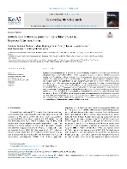miRNA and lncRNA as Potential Tissue Biomarkers in Hepatocellular Carcinoma

Author
Rajtmajerová, Marie
Publication date
2024Published in
Non-coding RNA ResearchVolume / Issue
9 (1)ISBN / ISSN
ISSN: 2468-2160Metadata
Show full item recordCollections
This publication has a published version with DOI 10.1016/j.ncrna.2023.10.010
Abstract
Hepatocellular carcinoma (HCC) is primary liver cancer, frequently diagnosed at advanced stages with limited therapeutic options. MicroRNAs (miRNAs) regulate target gene expression and through inhibitory competitive binding of miRNA influence cellular processes including carcinogenesis. Extensive evidence proved that certain miRNA's are specifically expressed in neoplastic tissues of HCC patients and are confirmed as important factors that can participate in the regulation of key signalling pathways in cancer cells. As such, miRNAs have a great potential in the clinical diagnosis and treatment of HCC and can improve the limitations of standard diagnosis and treatment. Long non-coding RNAs (lncRNAs) have a critical role in the development and progression of HCC. HCC-related lncRNAs have been demonstrated to exhibit abnormal expression and contribute to transformation process (such as proliferation, apoptosis, accelerated vascular formation, and gain of invasive potential) through their interaction with DNA, RNA, or proteins. LncRNAs can bind mRNAs to release their target mRNA and enable its translation.
Keywords
Hepatocellular carcinoma, Messenger Ribonucleic acid, Micro Ribonucleic acid, long noncoding Ribonucleic acid, Biomarkers, Prognostic, Diagnostic.
Permanent link
https://hdl.handle.net/20.500.14178/2108License
Full text of this result is licensed under: Creative Commons Uveďte původ-Neužívejte dílo komerčně-Nezpracovávejte 4.0 International







